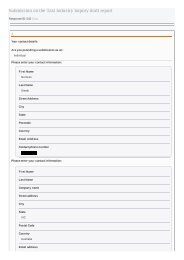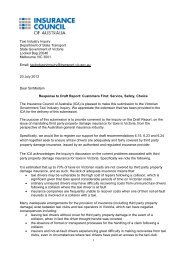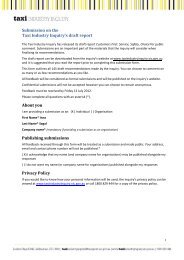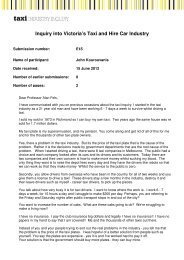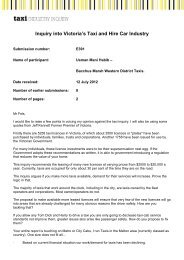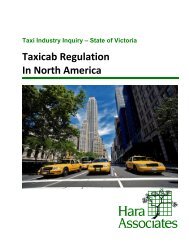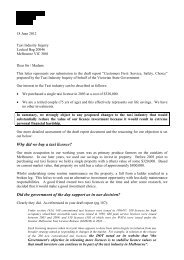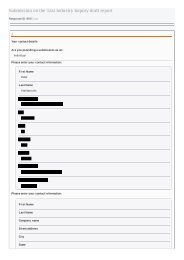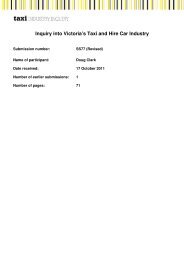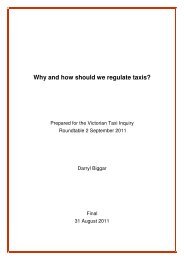Part D â Understanding and improving industry performance (PDF ...
Part D â Understanding and improving industry performance (PDF ...
Part D â Understanding and improving industry performance (PDF ...
Create successful ePaper yourself
Turn your PDF publications into a flip-book with our unique Google optimized e-Paper software.
Restrictions on entry provide an obvious justification<br />
for fare regulation. The scarcity of taxi licences means<br />
licence holders have market power, which cannot be<br />
eroded by competition. However, there may be a need<br />
for fare regulation even when there is no scarcity of taxi<br />
licences. This was raised at the inquiry’s Independent<br />
Roundtable by economist Dr Darryl Biggar who argued<br />
that the problems are not simply related to entry controls:<br />
…there seems to be a consensus that while there is<br />
scope for conventional market processes in certain<br />
taxi sub-markets – particularly the pre-booked market<br />
– in certain other taxi sub-markets there is limited or<br />
no scope for normal market processes. At least in<br />
those sub-markets, therefore, there seems to be an<br />
identifiable form of market failure. 103<br />
Market failures may occur due to the imperfect<br />
information <strong>and</strong> barriers to exercising consumer choice<br />
that are common in taxi markets. In these circumstances,<br />
competition from greater vehicle availability does not act<br />
to hold fares to reasonable levels. It has also been widely<br />
noted that these arguments primarily apply to ‘rank<br />
<strong>and</strong> hail’ taxis rather than pre-booked vehicles. This is<br />
perhaps another reason why hire cars have generally not<br />
been subject to explicit fare regulation.<br />
For example, the OECD notes that:<br />
Consumers who hail taxis on the street are uncertain<br />
about waiting time until the next taxi <strong>and</strong>, in a market in<br />
which fares have been deregulated, about the relative<br />
price of the currently available taxi <strong>and</strong> any taxis that<br />
may be able to be hailed in near future. Because<br />
waiting time is a significant element of service quality<br />
for taxis, they therefore face uncertainties as to both<br />
price <strong>and</strong> quality. Moreover, consumers are unable to<br />
keep the offer ‘in h<strong>and</strong>’ pending the arrival of a second<br />
cab. In these circumstances, monopolistic pricing is<br />
possible even in the presence of substantial numbers<br />
of producers. 104<br />
Others have also pointed out that particular passenger<br />
types may be more vulnerable to price gouging. Some<br />
customers, such as tourists, are less likely to provide<br />
repeat custom, so there is less incentive to provide<br />
exceptional service, or they lack of local knowledge<br />
<strong>and</strong> so may be taken advantage of. Customers in<br />
other circumstances, such as those with considerable<br />
baggage, the poorly informed <strong>and</strong> perhaps even<br />
customers who have concerns over safety <strong>and</strong> wish to<br />
be taken away from a particular locale, are all vulnerable<br />
to paying more than the market rate.<br />
The UK Office of Fair trading found that:<br />
The nature of the rank <strong>and</strong> hail sector of the taxi<br />
market makes it almost impossible for consumers to<br />
exercise choice on price as it is very difficult to shop<br />
around. Deregulating fares may therefore lead to<br />
higher prices. This is particularly important, for<br />
example for disabled consumers (who may not have<br />
access to alternative forms of transport), for those<br />
concerned about their safety (for example if they are<br />
catching a taxi late at night), or for those who do not<br />
know the local area. In these <strong>and</strong> other instances,<br />
fare regulation protects consumers from being<br />
overcharged. 105<br />
Notwithst<strong>and</strong>ing these arguments, the inquiry also<br />
notes that in an environment of restricted licence supply,<br />
owners of licences can extract profits from those actually<br />
providing the service. Regulation of fares offers one<br />
way in which these profits can effectively be controlled.<br />
However, this potential control has arguably been lost<br />
as the profits earned by licence owners are incorporated<br />
into fares as a legitimate cost for operators.<br />
10.5.4. Complexities in setting fares<br />
While fare control offers the community certain benefits,<br />
it may also impose some substantial costs. Some of<br />
these costs relate to the specific type of regulation that<br />
has been pursued in Victoria. Some costs appear likely<br />
to be prevalent regardless of the particular method of fare<br />
control. The primary costs identified by the inquiry include:<br />
• It reduces competition between taxi operators.<br />
• It stifles innovation by service providers that could<br />
potentially offer different kinds of services (whether<br />
lower or higher quality) with a different fare structure<br />
(such as fixed fares).<br />
• The degree of averaging in the fare structure,<br />
both across time <strong>and</strong> across geography, creates<br />
distortions in how drivers treat fares of different types<br />
(for example, favouring longer trips over shorter<br />
trips) <strong>and</strong> potentially inefficient vehicle utilisation (for<br />
example, large queues at the airport).<br />
• It legitimises the economic rents earned by licence<br />
holders, which are included in fare setting models as<br />
real costs to operators.<br />
• Fare regulation can also lead to ‘too much’ entry if<br />
fares are regulated at a level that allows inefficient<br />
firms (taxis with low utilisation) to prosper.<br />
103 Biggar, Darryl (2011), Op. Cit., p.12<br />
104 OECD (2007), Op. Cit., Background Note, p.19<br />
105 UK Office of Fair Trading (2003), The regulation of licensed taxi <strong>and</strong><br />
PHV services in the UK, OFT 676, p.60<br />
214




